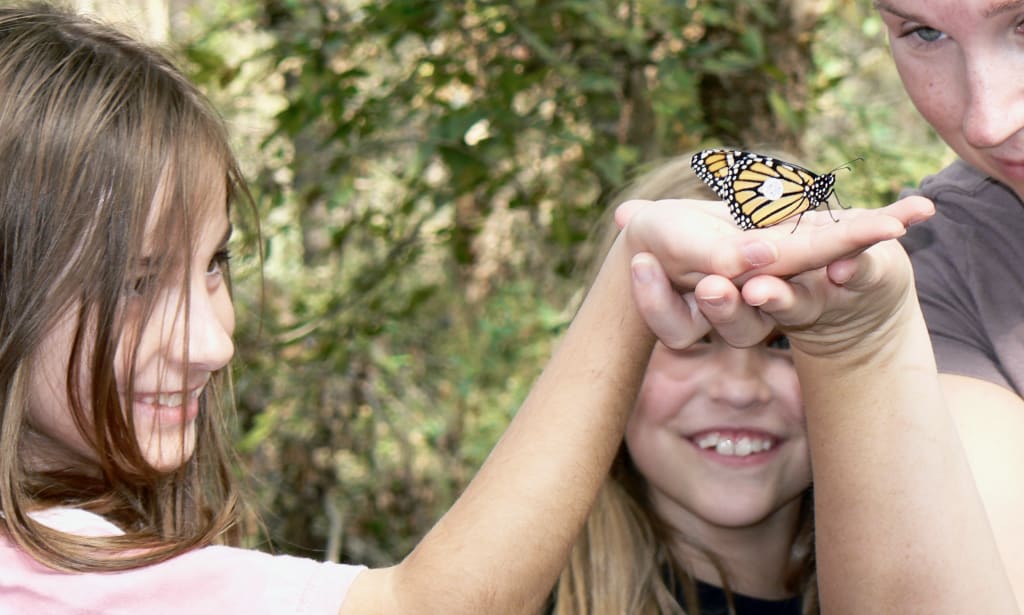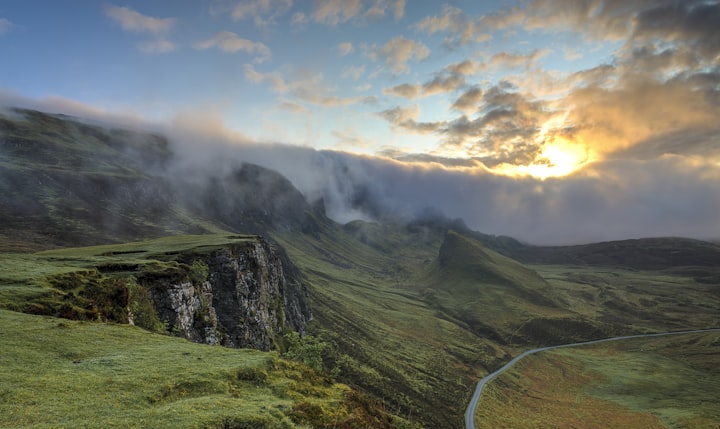Teaching a Monarch Butterfly to Play Dead
Today we will be Citizen Scientists tagging Monarch butterflies for the annual migration.

Today we will be Citizen Scientists tagging Monarch butterflies for the annual migration.
Dew-covered cobwebs blanketed the undulated landscape at the Heard Nature Science Museum and Wildlife Sanctuary in McKinney, Texas, on a cool autumn morning in 2007. The Sanctuary sits on less than 300 acres of untamed wilderness between suburban city sprawl in the Dallas Fort Worth area less than a mile from the major Highway 75 thoroughfare. The neighborhoods adjacent to "The Heard" are comprised of million-dollar homes on 1 acre lots. Yet, looking out over the natural tall grassed clearing we pulled up to and getting set to traverse, we saw an overgrown field of chest-high prairie grasses, scattered thistle and bramble dotted with goldenrod, milkweed, Indian paintbrushes, and johnsongrass. In addition, our guide, Scott, was happy to see us all in long sleeve shirts and jeans and protective footwear like rubber boots. He dutifully informed us of the possibility of stumbling upon all manner of wildlife such as water mocassin snakes, rattlesnakes, copperhead snakes, raccoons, foxes, bobcats, and hundreds of types of insects. Including ticks, we would have tick checks throughout the day, which meant finding a buddy and checking to see if any ticks could be found on their clothing or hair.
As budding citizen scientists, nine 5th grade girls and three moms soon learned the entomology and anatomy of the Monarch butterfly. To chrysalis from the eggs to the larvae instar phases, to the diet of the caterpillar, to the proboscis of the butterfly, and the powdery fore and hindwings and the scaly black spots only found on the males and the great migration of the super generation of the butterfly, which may take five generations. We learned this field is a bonanza for caterpillars as they can fly in on high winds, drop down to the tall trees that flank three sides of this clearing to cluster and roost for the night, and then comes the morning after the sun has warmed their wings they gently glide down to feast on the goldenrod and lay their eggs on the milkweed. Milkweed is the only food source for the emerging caterpillar, of which a myriad was found and left undisturbed. With a bit more training, nets, eagle eyes, documentation from Monarch Watch at the ready, the troop begin to spot Monarchs. Scott takes off bobbing and bounding through the sedges and the forbs, his net primed as he springs towards the downward gliding wanderers. They flutter and gently land on goldenrod before he reaches them, but he is close enough to make the catch when the time is right. Scott becomes quiet and still, targeting in on one prospective captive, waiting for the moment when the Monarch's wings are closed, and it has had time to take a small sip with its proboscis. With a swoosh and a flick of his wrist, he has netted the first of the 20 Monarchs we will collect, document, and release that day. Our butterfly guru gently gathers the net and makes his way back out of the brush to our group for more valuable lessons. In this lesson, he takes great care to demonstrates all the information he lectured to us while presenting the documentation needed to tag the Monarchs. As his captive audience, while he gently wrangles his physical captive out of the net by positioning it between his left-hand index and middle finger, handling it only by the abdomen to hold the wings the least amount of time. He instructs us on all the Monarch parts, points out the veins on each of the four wings, and notes this is a female with no scaly spots. Studying the underside of the hindwing, he reminds us to locate the mitten-shaped discal cell and that this is where we will be placing the tiny numbered specially designed sticker. I am happy to assist him in retrieving the tag to affix it to the discal cell. This placement is close to both the butterfly lift and gravity center and will not interfere with the creature's flight. The tag is transferred to his hand and gently placed as described, holding for 2 seconds. As Scott lets go with his left hand during the two short seconds, he flattens that hand, palm facing up, and the butterfly then does something he hasn't spoken of yet. It lays motionless in his hand. Scott exclaims, "and that is how you teach a Monarch to play dead." Several emotions are running through our collective conscious. I'm pretty sure not even one of us thought we could do what he just did with grace or ease, and then the obvious question is asked by one of the girls as our eyes are laser-focused on the motionless Monarch on his hand, but before the sentence is finished, it stands upright and then in a few seconds flutters out if his hand and into the clearing to gulp another drink of nectar. Scott says that some play dead for a few seconds and some longer, the ones that take longer can be gently coaxed to fly away by moving your flat outstretched hand up and down as he demonstrates this motion.
Scott demonstrates this catch and release system and the thorough documentation we will take on each specimen several times as we all watch in amazement. Eventually, our fears fall away like the gossamer blanket and morning dew, and we are all joining in to capture these beautiful sojourners.
One by one, our field guide ushers us through the process of catch, tag, document, release until we each experience at less one un-assisted wrangle. This particular Monarch was a sleepy lady we crowned Queenie. Queenie laid motionless for much longer than the others we caught that day.
Pictured here, Queenie's custodian tries to wheedle her away to join her bivouac for a minute or so. Then, as we all gathered around in amazement, cajoling her while another of us novice Monarch taggers joined to help Queenie take flight, she stood up and walked around her reinforced pedestal. I leaned in for the shot, snapped it, and Queenie fluttered up into the canopy and then back down far into the middle of the grassy clearing. The entire day was as miraculous as this shot. It still fills my heart with wonderment and joy to know we helped Queenie in her expedition and Monarch Watch by gathering valuable information about these magnificent creatures.
About the Creator
JoAnne Scalf
I scribe stories and prose and am an author of a popular epidemiological study. I’m an artist and budding novelist on a mission to create engaging works that connect with readers.






Comments
There are no comments for this story
Be the first to respond and start the conversation.